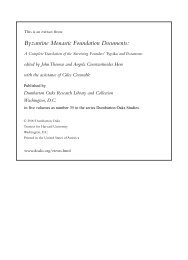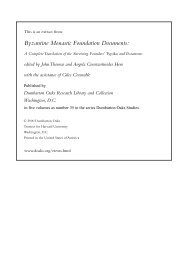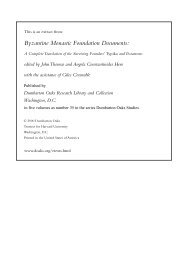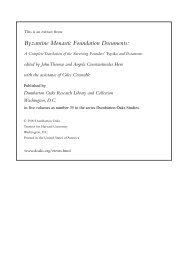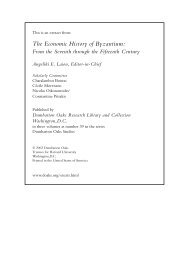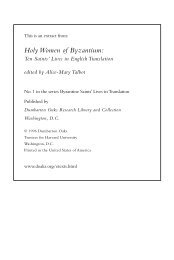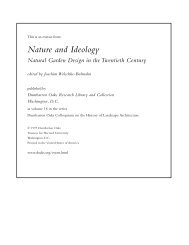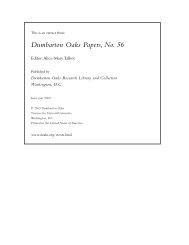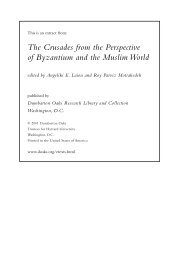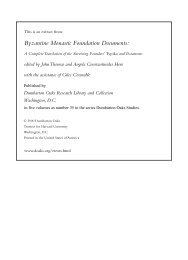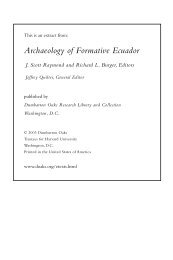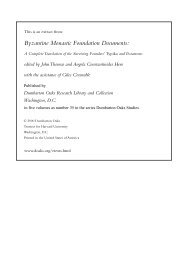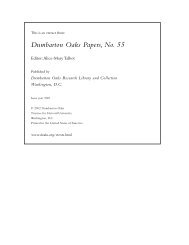Gold and Power in Ancient Costa Rica, Panama ... - Dumbarton Oaks
Gold and Power in Ancient Costa Rica, Panama ... - Dumbarton Oaks
Gold and Power in Ancient Costa Rica, Panama ... - Dumbarton Oaks
Create successful ePaper yourself
Turn your PDF publications into a flip-book with our unique Google optimized e-Paper software.
9 Introduction: The <strong>Gold</strong>en Bridge of the Darién<br />
from great distances, but they probably required the ma<strong>in</strong>tenance of complicated <strong>in</strong>traregional<br />
exchange systems.<br />
Whereas lapidary work was straightforward <strong>and</strong> laborious, goldwork<strong>in</strong>g was complicated<br />
<strong>and</strong> mysterious but relatively quick, once all of the necessary materials were assembled.<br />
There is considerable evidence that high-status <strong>in</strong>dividuals were active <strong>in</strong> gett<strong>in</strong>g, work<strong>in</strong>g,<br />
<strong>and</strong> socially us<strong>in</strong>g gold (Cooke et al., <strong>in</strong> this volume). Some examples of attitudes toward<br />
gold, such as Chief París tak<strong>in</strong>g back a gold gift (Ibarra, <strong>in</strong> this volume), suggest that the<br />
appreciation <strong>and</strong> valuation of gold was not always limited to its physical properties, but also<br />
extended to its value as capital. If so, this is a significant po<strong>in</strong>t that deserves future study.<br />
Not much is known about how jade objects circulated, but, as noted by Ibarra, h<strong>in</strong>ts of<br />
their value are provided <strong>in</strong> the histories of these objects, as <strong>in</strong> the case of the shell goods of<br />
the Kula R<strong>in</strong>g of the Trobri<strong>and</strong> Isl<strong>and</strong>s or the great “coppers” of the Canadian west coast.<br />
Jades were cut <strong>in</strong> two, further divided, <strong>and</strong> reworked. In carv<strong>in</strong>g, cutt<strong>in</strong>g, <strong>and</strong> layer<strong>in</strong>g marks<br />
on the surface of these precious stones, the workers <strong>and</strong> owners created historical documents.<br />
Splitt<strong>in</strong>g a Maya jade belt plaque did not necessarily demonstrate a disregard for the<br />
object’s history but may <strong>in</strong>stead have added to its historical depth. Rather than a desecration<br />
of an essential, complete object, splitt<strong>in</strong>g may have expressed a historical sensibility <strong>and</strong><br />
represented an empower<strong>in</strong>g act through which a received, foreign object was appropriated<br />
as one’s own.<br />
Reworked gold does not always show its history <strong>in</strong> a similar manner, for it may go back<br />
to the crucible to be reformed <strong>in</strong>to someth<strong>in</strong>g new. In these cases, as passed down to future<br />
generations, it does not bear its history directly. Its form—an antique or foreign style—may<br />
<strong>in</strong>dicate aspects of its history, but the object does not physically bear the mark<strong>in</strong>gs of that past<br />
on its substance as does a reworked jade.<br />
<strong>Gold</strong> was offered <strong>in</strong> mortuary rites <strong>in</strong> quantity, as illustrated by the huge amounts<br />
looted from cemeteries throughout the Isthmus <strong>and</strong> Colombia. It is unlikely that jade was<br />
ever available <strong>in</strong> such abundance. This most precious greenstone was an exotic substance<br />
from l<strong>and</strong>s far away, but once <strong>in</strong> the h<strong>and</strong>s of local people it survived, until eventually buried<br />
<strong>in</strong> a grave, as a marker of great temporal depth of historical cont<strong>in</strong>uity rather than the achievement<br />
of territorial distances covered.<br />
The k<strong>in</strong>ds of technical changes discussed here are highlighted by Alfred Russel Wallace’s<br />
(1969 [1853]) account of quartzite stone cyl<strong>in</strong>ders worn by Cubeo men of the Vaupés River<br />
<strong>in</strong> the northwest Amazonian region (Fig. 1). Slightly harder than jade, quartzite was procured<br />
from a great distance up the Río Negro, at the base of the Andes. The cyl<strong>in</strong>drical artifacts<br />
Wallace describes measured four to eight <strong>in</strong>ches long, were about an <strong>in</strong>ch thick, <strong>and</strong> were<br />
pierced at one end for suspension. To drill such a hole was said to take years, <strong>and</strong> to drill a<br />
hole for transverse suspension through the length of the cyl<strong>in</strong>der—worn only by the highestrank<strong>in</strong>g<br />
men—was purported to take two lifetimes. 3<br />
3 I thank David Watters for draw<strong>in</strong>g my attention to this citation. The full account is as follows: “I now saw<br />
several of the men with their most peculiar <strong>and</strong> valued ornament—a cyl<strong>in</strong>drical, opaque, white stone, look<strong>in</strong>g<br />
like marble, but which is really quartz imperfectly crystallized. These stones are from four to eight <strong>in</strong>ches long,<br />
<strong>and</strong> about an <strong>in</strong>ch <strong>in</strong> diameter. They are ground round, <strong>and</strong> f lat at the ends, a work of great labour, <strong>and</strong> are each




